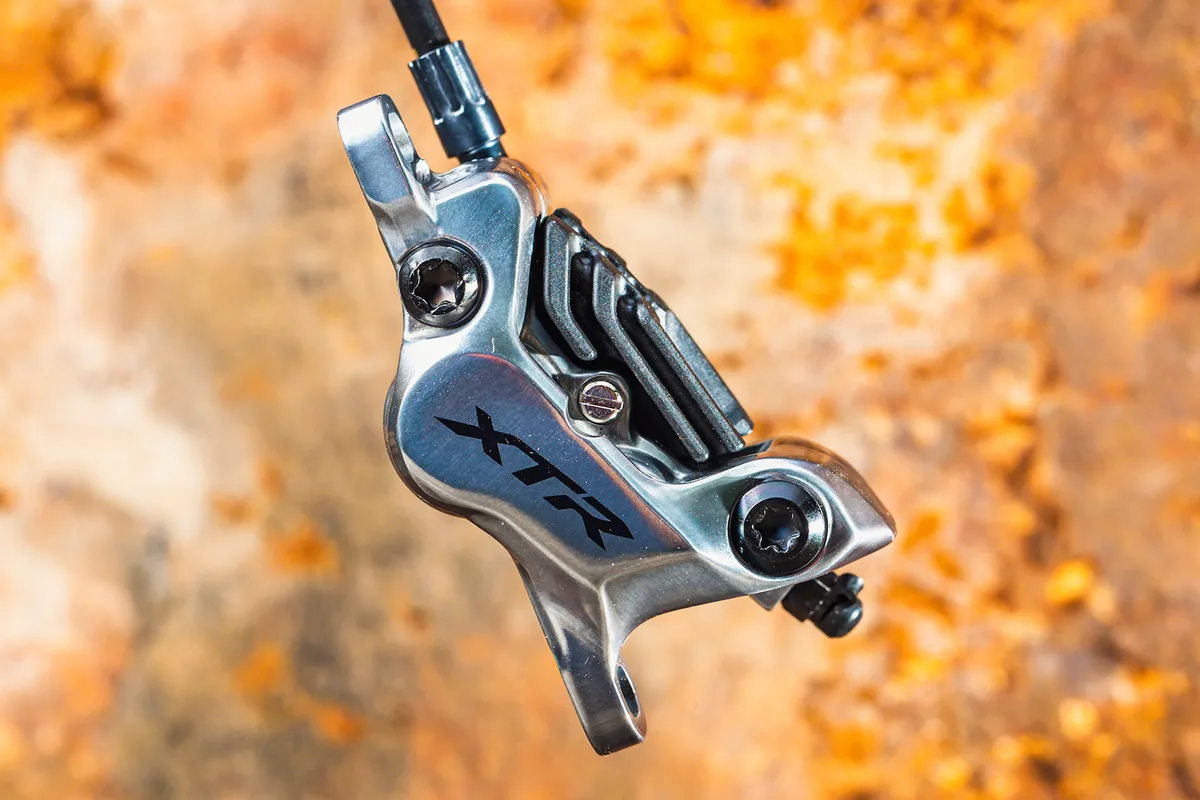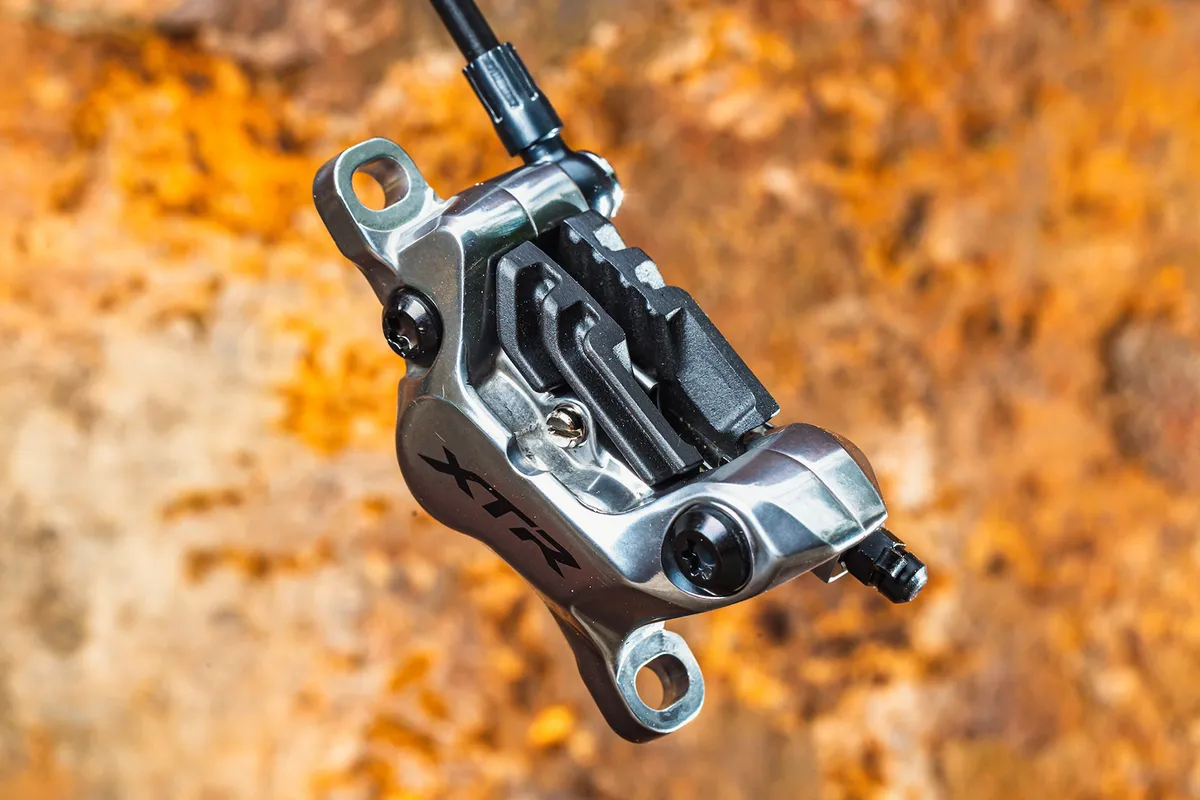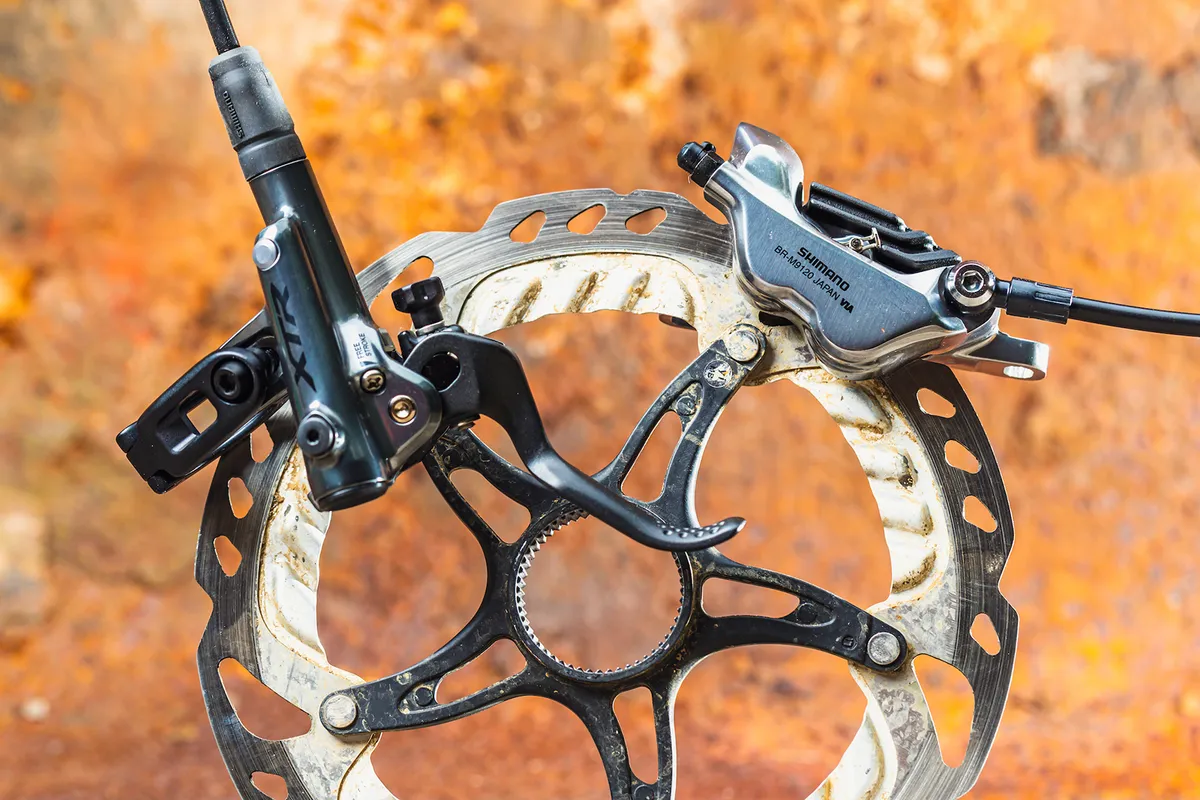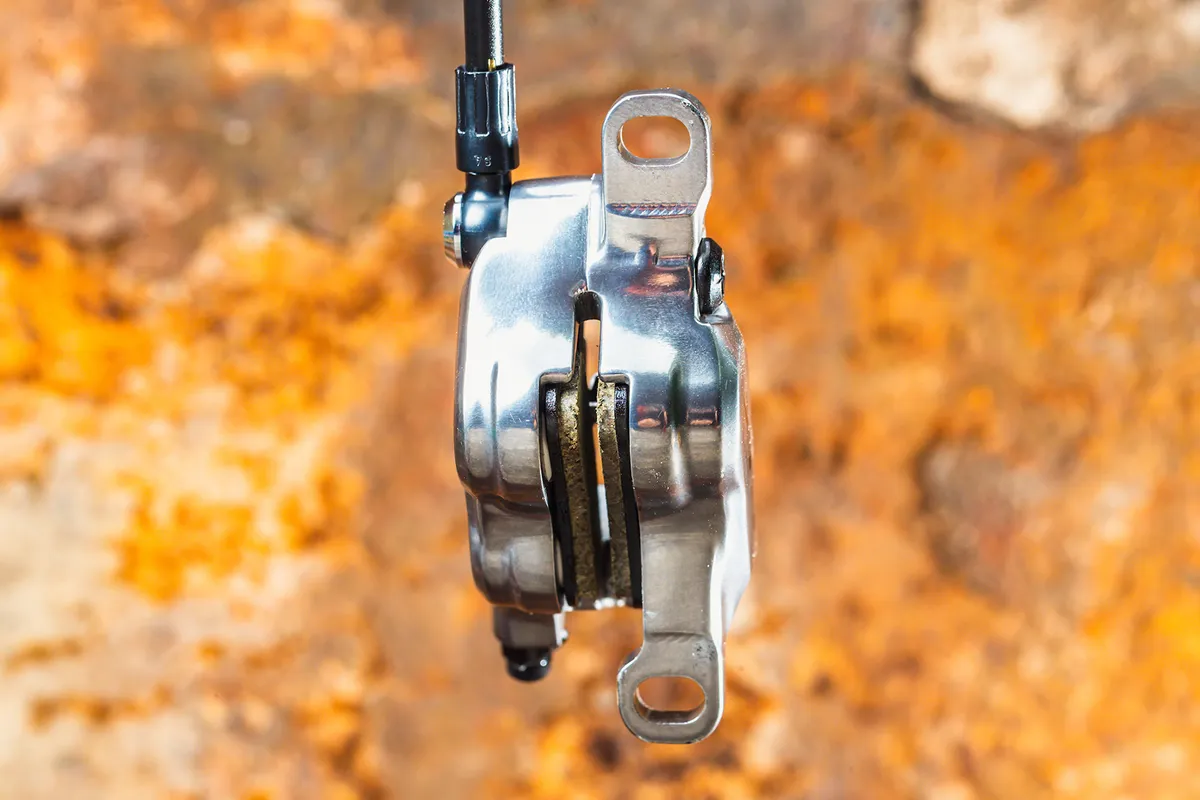Shimano’s XTR range has always been the pinnacle of its mountain bike groupsets. It’s the first to get the newest technologies, it has the lightest materials and the most features. Certainly, this comes at a cost, but if you want the best that it produces, this is always going to cost.
The M9120 version of the brakes has four pistons, and mine came with a set of finned, sintered pads. If you want a lighter weight brake, which still says XTR on the caliper, look for the M9100 series, or the M9110 caliper if your frame requires a flat-mount caliper.
Shimano XTR Trail disc brakes detail
Shimano’s higher-end lever blades always look a little stubby compared to many of the competition, however, their shape and Shimano’s trademark snappyness mean they’re a comfortable and secure item to pull upon. The lever blade has a dimpled texture for extra wet-weather security.
Shimano’s Servowave system means the early portion of your lever pull pushes the caliper’s pistons further than the later stroke of the lever, enabling a little extra pad clearance at the back, aiding mud performance and allowing for a little extra give or take when getting wheels in and out. Despite this extra lever control, the feeling is still crisp and smooth.
The lever blade’s position is adjustable thanks to a thumb screw on the outside of the lever pivot, and there’s a reasonable range of adjustment available.
The Freestroke adjustment (bite point adjustment) is done via a crosshead screw – it’s easy enough to access, though I’d rather see an Allen bolt. The same can be said at the caliper end, where a flat-head screwdriver is needed to remove the pad’s retaining pin.

Back to the lever. The clamp has a split design, with the bolt loading from the top. In my experience, this makes it easier to not lose the bolt and because it’s captive (via a rubber grommet), you shouldn’t anyway – it’s still a nice touch, though.
However, like other Shimano brakes, a 2mm Allen key is needed to open the clamp, to push in to ‘unlock’ it – which seems unnecessary, and the little locking pin sometimes doesn’t want to unlock.
Like SLX and XT brakes, the clamp sits mid-way along the lever body, with a small supporting tab towards the grip end of the lever body. This gives excellent lever body stiffness, and aids the sharp feel of the brake, though it does take up extra bar real estate – I’d use Shimano’s I-Spec shifter mounts or an aftermarket version if you’re using SRAM shifters.
The levers aren’t flip-flop in design, so make sure you purchase the correct left/right, front/rear combo.
At the caliper, there are four pistons pushing on a finned sintered pad. The pad is finned in order to aid cooling, with the fins sucking heat from the pads and then expelling it into the air flowing around them.

I’ve found that finned pads can rattle a little on rough descents, often when the spring doesn’t have the strength to push back sufficiently, and when pads are more worn.
The bolts supplied with the brakes are lighter weight than the standard bolts, but be aware that if you’re using adaptors to increase rotor size, the standard Shimano bolts will be too short.
Bleeding the brakes was easy, though the instructions Shimano supplies aren’t the clearest – online guides make life easier here. The 1,000mm (front) and 1,900mm (rear) hoses are a good length, and feed into the caliper via an adjustable banjo that makes getting hose routing in the rear triangle of your bike nice and tidy.
Shimano XTR Trail disc brakes performance
Shimano brakes are known for their sharp bite, but the XTR Trail brakes seem to take this to another level, with one of our testers describing their feel “like a wall of power”. Stopping power is delivered through the brakes as soon as the pads touch the rotor.
This takes a little bit of getting used to and there will certainly be riders who won’t like this feeling – it’s very different to that of a SRAM or Magura brake, and the complete opposite end of the scale to Formula’s offerings.

What it does mean is that you’re under no illusion that the brake means business. Once you’re past that initial snap, it is possible to modulate the power on offer, though it takes a little more finesse via your finger squeeze to truly control every ounce of power that’s there. It feels like the wide range of power isn’t quite in line with the range of lever movement, which is a touch more limited.
All said, though, if you like the direct feel, helped by the structurally stiff lever, Shimano’s top-flight brakes are some of the best on offer when it comes to trail and enduro applications.
At the top end, they give nothing away to SRAM’s Code brakes or Magura’s MT5s, and they come in a suitably lightweight, well-finished and attractive package.

The Trail version of the brakes, as tested here, come with the optional finned pads.
Experience suggests that heat management is good with the brakes, with minimal pump up or fade on long, hot descents. The added weight of the pads can lead to a little bit of rattle, though, which can be annoying.
In terms of lever feel itself, there’s a little more friction to overcome at the start of the stroke than with some brakes, so they sit mid-table in terms of lever feel lightness. They certainly don’t have the return spring force of Hope’s Tech 3 lever.
That said, a lighter feel would improve their performance a touch. I tend to keep the fairly open architecture at the rear of the lever as clean as possible because it’s easier for mud to collect here than it is with some other brakes.
Over the past few years, I have had issues with wandering bite points from Shimano brakes, and more recently some seeping of the seals on its XT brakes, but I've had no issues with this set of XTR brakes, and my general feeling is that the bite point issues are less common than they used to be with Shimano’s brakes.
Shimano XTR Trail disc brakes bottom line
Shimano’s flagship brakes have incredible levels of power, delivered by one of the tidiest packages on test.
Brake feel is a personal thing, but I like the direct, confident feel that the XTR brakes provide – be wary, though, if you’re used to brakes from other manufacturers because they have such a distinct feel.
How we tested
We rounded up 12 powerful hydraulic brakes to find out which are the ultimate speed-scrubbers.
To get to know what it’s like to live with these brakes, we asked the brands to send us their official bleed kit, then trimmed the hoses to our ideal length.
As such, we’ve cut and bled every set we tested to see just how easy they are to maintain. Then we saddled up to see how they performed on the trails.
Overall braking power is important, but so too is the ease with which you’re able to access that power – if you have to squeeze the lever really hard, that’s likely to lead to arm pump. Brake ‘feel’ is another key aspect – it’s subjective, but some people like a really grabby feel, while others prefer the power to progressively build as you squeeze the lever. We also needed to work out just how powerful the brakes are, and how resistant to heat build-up.
So, with the help of both leg power and some electrical assistance, we took them to the top of some of the South West’s steepest slopes and pointed our bikes downhill to see how these 12 stoppers coped.
Note: Weights and prices are for a single brake (caliper, hose and lever, but no rotor or adaptor, unless otherwise stated).
Also on test
- Clarks M2 Disc Brake
- Formula Cura disc brakes
- Hope Tech 3 V4 disc brakes
- Magura MT Trail SL disc brakes
- Magura MT5 disc brakes
- Shimano BL-MT501/MT520 disc brakes
- Shimano SLX M7120 disc brakes
- Shimano XTR Trail disc brakes
- SRAM Code RSC disc brakes
- SRAM G2 Ultimate disc brakes
- Tektro HD-M285 disc brakes
- TRP Slate T4 Evo disc brakes
Product
| Brand | shimano |
| Price | 240.00 GBP |
| Weight | 560.0000, GRAM () - calliper, hose and lever - for front and rear |
Features
| br_brakeType | hydraulic_disc |
| Features | Pistons: 4 Fluid: Mineral oil Weight: 272g (f) 288g (r) Details: Split lever clamp; I-Spec mounting options |
| br_adjustment | Reach (TF), bite point (TD) |
